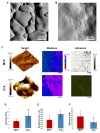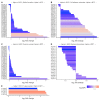Effect of a Stannous Fluoride Dentifrice on Biofilm Composition, Gene Expression and Biomechanical Properties
- PMID: 36144293
- PMCID: PMC9506307
- DOI: 10.3390/microorganisms10091691
Effect of a Stannous Fluoride Dentifrice on Biofilm Composition, Gene Expression and Biomechanical Properties
Abstract
An in situ study was conducted to examine the mode of action of a 0.454% stannous fluoride (SnF2)-containing dentifrice in controlling the composition and properties of oral biofilm. Thirteen generally healthy individuals participated in the study. Each participant wore an intra-oral appliance over a 48-h period to measure differences in the resulting biofilm's architecture, mechanical properties, and bacterial composition after using two different toothpaste products. In addition, metatranscriptomics analysis of supragingival plaque was conducted to identify the gene pathways influenced. The thickness and volume of the microcolonies formed when brushing with the SnF2 dentifrice were dramatically reduced compared to the control 0.76% sodium monofluorophosphate (MFP)-containing toothpaste. Similarly, the biophysical and nanomechanical properties measured by atomic force microscopy (AFM) demonstrated a significant reduction in biofilm adhesive properties. Metatranscriptomic analysis identified pathways associated with biofilm formation, cell adhesion, quorum sensing, and N-glycosylation that are significantly downregulated with SnF2. This study provides a clinically relevant snapshot of how the use of a stabilized, SnF2 toothpaste formulation can change the spatial organization, nanomechanical, and gene expression properties of bacterial communities.
Keywords: dental plaque; oral biofilm; oral health; oral microbiome; stannous fluoride; toothpaste.
Conflict of interest statement
H.K.G., A.S.L., K.I.F., K.M. and L.K.-L. are current employees of Colgate-Palmolive. T.S. and R.P. were Colgate-Palmolive employees at the time the study was conducted.
Figures












References
Grants and funding
LinkOut - more resources
Full Text Sources
Other Literature Sources
Miscellaneous

